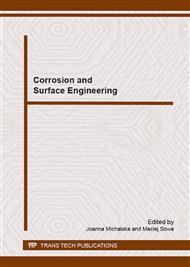p.59
p.63
p.67
p.71
p.75
p.79
p.83
p.87
p.91
Studies on the Corrosion Properties of High-Mn Austenitic Steels
Abstract:
Institute of Materials Science at Silesian University of Technology since 6 years conducts researches to learn about the new dedicated for automotive, railway and military industries. Some of these materials belong to the group of AHS steels, characterized by the twinning induced plasticity (TWIP) effect. It is a new type of steel possessing both a high strength and a great plastic elongation, and an ideal uniform work hardening behaviour. It is therefore a good candidate for deep drawing applications in the automobile and railway industries. In the paper the of the three grades of high-manganese steels of was studied in 3.5% NaCl solution and in an “acid rain” solution with pH=3.5 environments using polarization experiments. The results of corrosion tests and analysis of show that a higher polarisation resistance and lower values of corrosion current density are observed for all studied steels in 3.5% NaCl solution. Spontaneous passivation ability has been shown only for one grade of high-manganese steel in 3.5% NaCl.
Info:
Periodical:
Pages:
75-78
Citation:
Online since:
January 2015
Authors:
Price:
Сopyright:
© 2015 Trans Tech Publications Ltd. All Rights Reserved
Share:
Citation:


